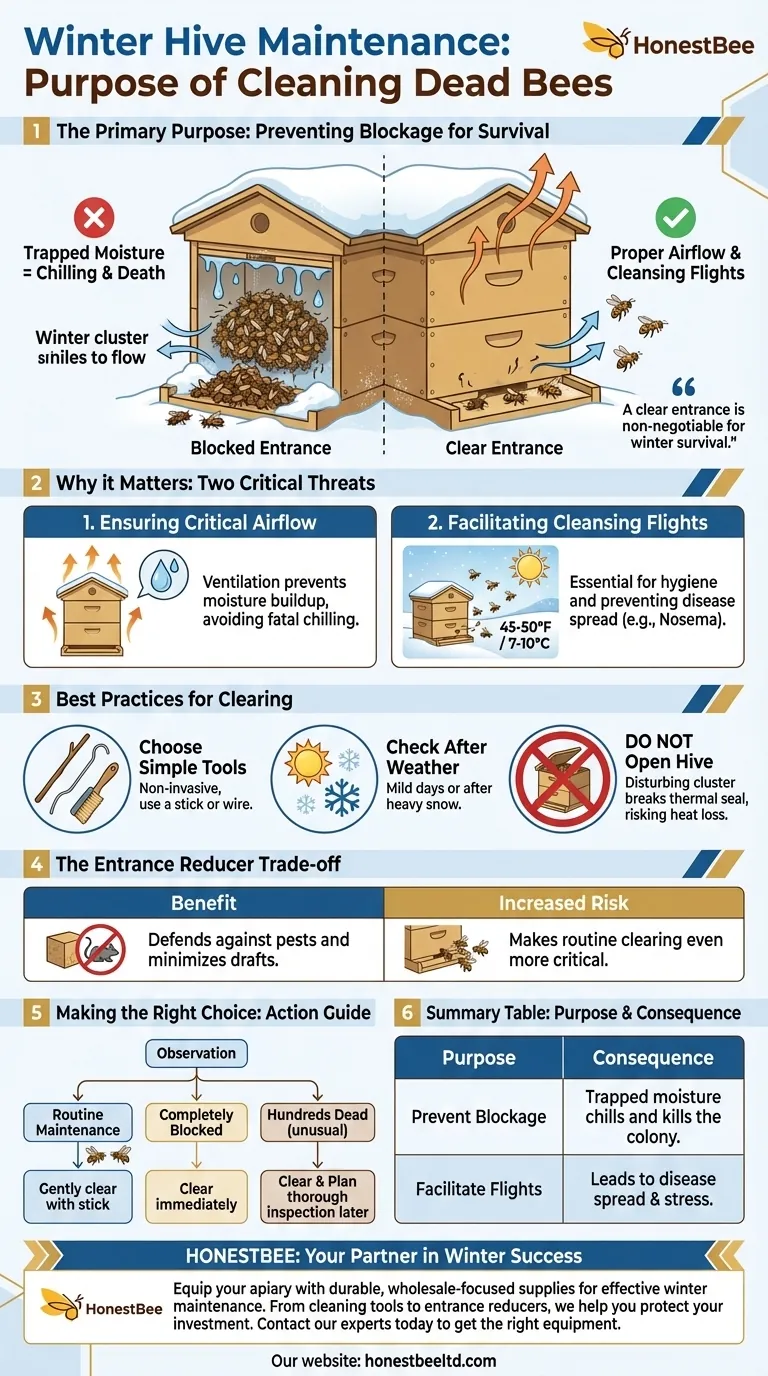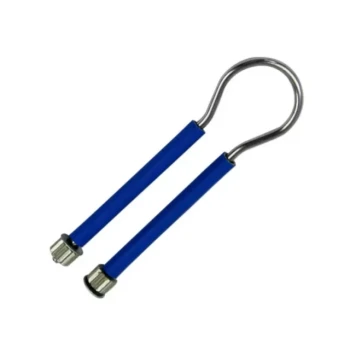The primary purpose of cleaning dead bees from a hive entrance in winter is to prevent a blockage. A clear entrance is essential for maintaining proper air ventilation and allowing the colony to take vital "cleansing flights" on warmer days.
A small number of dead bees at the hive entrance is a normal sign of a healthy winter cluster. The real danger isn't the presence of dead bees, but the potential for them to accumulate and create a seal that suffocates the colony and traps them inside.

Why a Clear Entrance is Non-Negotiable in Winter
A blocked entrance creates two immediate threats to a wintering colony's survival. Understanding these threats is key to proper winter management.
Ensuring Critical Airflow
A honey bee cluster generates heat and moisture throughout the winter. Proper ventilation is crucial to allow this moist air to escape.
If the entrance is blocked, moisture gets trapped inside the hive. This condensation can drip down onto the bees, chilling them far more effectively than cold, dry air, which can lead to the death of the entire colony.
Facilitating Cleansing Flights
Bees are exceptionally hygienic and will not defecate inside the hive. On milder winter days (typically above 45-50°F or 7-10°C), they must be able to exit the hive for brief cleansing flights.
A blocked entrance prevents these essential flights. This can lead to the spread of disease, such as Nosema, within the colony and cause unnecessary stress on the bees.
Best Practices for Clearing the Entrance
Clearing the entrance should be a quick, non-invasive process. The goal is to cause the least possible disturbance to the winter cluster.
Choose a Simple Tool
You do not need specialized equipment. A long, thin object is all that is required to gently rake the dead bees out of the entrance.
Commonly used tools include a sturdy stick, a bent piece of wire from a coat hanger, or the handle of an old bee brush.
Check After Key Weather Events
The best time to check the entrance is on a mild day or after a significant snowfall. Dead bees can accumulate quickly, so periodic checks are a good habit.
Do Not Open the Hive
It is critical that you never open the hive to clean bees in the cold. Disturbing the winter cluster breaks their thermal seal, causing a massive loss of heat that can be fatal to the colony. All clearing should be done from the outside through the entrance.
Understanding the Trade-offs: Entrance Reducers
Many beekeepers use an entrance reducer in the fall to prepare for winter. This is a small block of wood that narrows the main hive entrance.
The Benefit of a Smaller Opening
Reducing the entrance helps the colony defend against pests like mice seeking a warm place for winter. It also helps minimize cold drafts from entering the hive.
The Increased Risk of Blockage
The downside of a smaller opening is that it becomes blocked much more easily. A reduced entrance makes the routine task of clearing dead bees even more critical for survival.
Making the Right Choice for Your Goal
Your observations at the hive entrance can tell you what action, if any, is needed.
- If your primary focus is routine maintenance: Check the entrance periodically, especially on milder days, and use a stick or wire to gently clear any minor accumulation of dead bees.
- If you find the entrance is completely blocked: Clear it immediately to restore airflow and ensure the bees can exit for cleansing flights when the weather permits.
- If you observe an unusually large number of dead bees (hundreds): This could indicate a larger problem like starvation or disease. While you should not open the hive, make a note to perform a thorough inspection as soon as a warm day allows.
Monitoring your hive's entrance is one of the simplest and most effective ways to ensure your colony's health through the winter.
Summary Table:
| Purpose | Key Reason | Consequence of Inaction |
|---|---|---|
| Prevent Blockage | Maintains airflow to reduce deadly condensation. | Trapped moisture chills and kills the colony. |
| Facilitate Flights | Allows bees to leave for essential cleansing flights. | Leads to disease spread (e.g., Nosema) and stress. |
Ensure your apiary is equipped for success. Proper winter management starts with the right tools and knowledge. HONESTBEE supplies commercial apiaries and beekeeping equipment distributors with the durable, wholesale-focused supplies needed for effective hive maintenance year-round. From simple cleaning tools to entrance reducers, we help you protect your investment. Let's discuss your apiary's needs — contact our experts today to get the right equipment for a thriving season.
Visual Guide

Related Products
- HONESTBEE Professional Multi-Functional Hive Tool with Ergonomic Wood Handle
- Professional Dual-End Stainless Steel Hive Tool for Beekeeping
- Multi-Function Plier-Style Frame Grip Hive Tool
- HONESTBEE Professional Long Handled Hive Tool with Precision Cutting Blade
- HONESTBEE Premium Italian Style Hive Tool with Hardwood Handle
People Also Ask
- What is the hole in a hive tool for? A Multi-Tool for Apiary Repairs and Maintenance
- What safety precautions are advised for beekeeping with hive tools? Master Safe Handling for Calm, Efficient Hives
- What are the features of a J-hook hive tool? Effortlessly Lift Frames with Superior Leverage
- Why do hive tools have a hole? Unlock the Secret to Efficient Beekeeping
- What should beginners consider when purchasing beekeeping equipment? A Guide to Essential Starter Gear



















